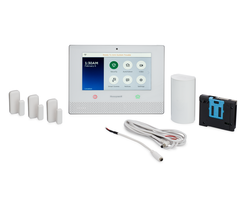New 2GIG Products from Alarm Grid
Posted By Michael GorisHi DIYers! Today, we'd like to cover some of our newest products from 2GIG. These are all fairly unique 2GIG 345 MHz Sensors that can be used with 2GIG GC2, 2GIG GC3 and Honeywell Lyric Alarm Systems. We are sure that many users will take full advantage of these versatile new products!

We actually very briefly touched on these new sensors during our 2GIG ISC West 2019 Post, but we never had the opportunity to discuss them in-depth. These sensors will also work with the upcoming 2GIG GC2e and 2GIG GC3e Systems that should be arriving later this summer. Remember, these upcoming panels will support a lineup of encrypted sensors from 2GIG, as well as the current 2GIG 345 MHz Sensors and Honeywell 5800 Series Sensors.
As we said before, these are all fairly unique sensors. Some of these options have never truly been offered before. It's a good reason to get on-board with 2GIG and one of their wireless systems. And remember that you can always add a 2GIG RPTR1-345 Wireless Repeater if you need to increase the signal range for any of these wireless devices. Let's take a few moments to discuss each of these new sensors in full detail:
-
2GIG DW30-345 Outdoor Wireless Door Sensor: This a wireless outdoor contact sensor, much like the existing Honeywell 5816OD. The weather-resistant sensor can have an extended gap of two (2) inches between its magnet. However, it should ideally be less than an inch if possible for best results. It receives power using two (2) AA batteries, which can easily be swapped out when low. The 2GIG DW30-345 is great for outside doors, fences and gates that may be exposed to rain, wind, snow and excessive dust. It can be mounted on a flat or curved surface to meet the needs of the user.
-
2GIG STVGRL1-345 Stove & Grill Guard: This is a unique sensor that alerts an alarm system when a stove or grill has a burner that is left on. The sensor will remain in a fault condition whenever the burner control is left 20 degrees or more from the usual position. A user can set the associated wireless zone to display a trouble condition whenever the sensor left faulted. This way, they will know to turn the stove or grill off if they accidentally leave it on. It is also great for parents who are worried that their children may be playing with the burner. The device is small and discreet, and it is suitable for indoor and outdoor use.
-
2GIG F1-345 Safety Pendant With Fall Detection: This is a medical alert sensor that can detect the abrupt and sudden movement that occurs when a person falls down. Just like a conventional medical alert sensor, the user can press and hold a button if they experience a medical emergency or crisis. But the built-in fall detection is great for situations in which the user might be rendered unconscious and unable to press the button themselves. The device comes with a lanyard so that it can be easily worn, and it it is water-resistant with an IPx7 rating. The end user will have no problem using the F1-345 in the bath or shower if necessary.
-
2GIG GNGRD1-345 Gun Trigger Lock: This a helpful safety device that prevents a user from shooting a gun or firearm unless a 3-digit code is entered first. The sensor will also send an alert to the security system in the event that the weapon is moved or tampered with. This sensor is perfect for families of gun-owners who want to make sure that their children don't get into their weapons or firearms. It is strongly recommended for any gun-owner who wants to ensure that only they can access their weapon. The device is small, discreet and easily to apply. It is powered using a single CR2032 coin cell battery.
All of these sensors are available on the Alarm Grid website now! If you would like to learn more about any of these sensors, we recommend sending an email to support@alarmgrid.com. One of our security system experts will see your email and respond back as soon as possible. We look forward to hearing from you and helping you design the perfect alarm system for your needs!















